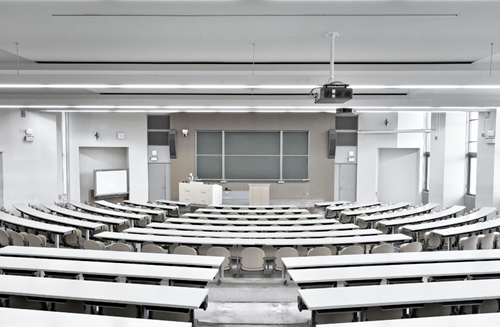Rethinking Remote Learning with High-Quality Audio

Students attending lectures online. Professors delivering classes from a remote office. Hybrid home-based and classroom models. You name it, 2020 has witnessed a huge disruption in the way the Higher Education sector delivers learning.
What hasn’t changed is the overarching pursuit of academic excellence. Faculty heads and administrators moved fast to migrate lectures online. Indeed, some of the world’s best-known universities announced that all lectures would be held remotely.
As a short-term measure, remote learning continues to work. But it has quickly become clear that shortfalls in audio quality are having a negative impact on the learning experience. For those academic institutions competing to attract new students, the offer of remote learning and lecture capture is seen as essential– but only if it’s inclusive and educationally advantageous.
Building a Community
We know that the group experience of learning typical in a classroom setting is important for many students. The student-to-student interaction helps to hone debating skills and build a sense of community. With the bulk of learning moving online, the challenge has been how to retain this community ethos.
Matt Russell of long-standing Shure representative Richard Dean Associates explains: “It’s fair to say that in the initial rush to get remote learning up and running, audio quality wasn’t the first consideration. But it is now.
“Students joining from home need to be able to pick up every nuance of a lecture, whether it’s being delivered from a classroom or office by a professor to students at home, or in a space where attending students are socially distanced. They need to be part of the conversation. To be in a shared community. We have been working with a number of Higher Education institutions to make this possible. How? With the ability to hear and be heard.”
Shure Microflex® Advance™ Array Microphones (MXA) are proving popular choices for these applications. Offering pinpoint audio accuracy for students and teachers, MXA microphones deliver effective, touch free coverage from all corners of a classroom, theatre or auditorium to clearly capture the speech audio of everyone in the room.
Both the MXA910 Ceiling Array Microphone and the MXA710 Linear Array Microphone feature Steerable Coverage™ technology, with default templates for quick deployment. Microphone coverage lobes can be aimed to capture the voices of teachers and students throughout a room. Both microphones feature IntelliMix® digital signal processing (DSP) technology, which helps to remove echo and unwanted noise and dramatically improve audio quality of the talker’s voice. Both microphones are part of the Shure Audio Ecosystem, offering the complete audio signal chain, from microphone to DSP to loudspeaker, with unmatched ease of deployment, less complexity, and remote management.
4 Things That Will Help Improve Audio for Learning
According to Richard Dean VP Bill King, universities and colleges recognize the value of flawless audio in ensuring a high-quality learning experience.
However, it’s not a simple case of putting in the tech and hoping it all goes to plan. Bill asserts that there are several audio considerations that will make a difference to both the quality of the outcome and the choice of solution:
- Acoustics – Capturing the spoken word at a distance is always a challenge, but one that becomes more significant with poor room acoustics. Fortunately, most classrooms, especially lecture spaces, were designed with a need for high-level intelligibility in mind, making products like the MXA710 or MXA910 well suited for these rooms.
- Placement – All classrooms were designed to provide line of sight to the teacher from all seating positions – that goes without saying. However, AV equipment was not always part of the design considerations. Shure addresses this challenge with multiple form factors and mounting options to provide an assortment of placement solutions. This is particularly relevant when students are socially distanced.
- Room Capacity – There are limits to what can be achieved with current technology for capturing speech intelligibility at a distance. The use of multiple microphone arrays with best-in-class IntelliMix DSP technology ensure that the best mic and lobe is activated for each talker, accommodating learning spaces of all sizes from classrooms to lecture halls to auditoriums.
- Clarity – While no one expects to record a string quartet at 50 or more feet, we can show clear vocal intelligibility at a distance that can make a group conversation using conferencing a reality in a larger space (especially for remote students) and at a cost that fits college budgets.
These considerations are shaping the conversations that Bill and Matt are having with Heads of AV at Higher Educational establishments across America. Matt says: “From large auditoriums and lecture halls, to small, multi-room campuses, we’re making this technology work. The key is to stay focused on enabling an inclusive audio experience. To effortlessly connect students with each other and their classes with flawless audio – from anywhere.
